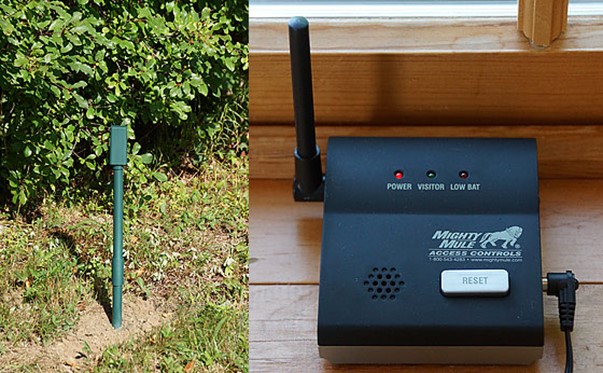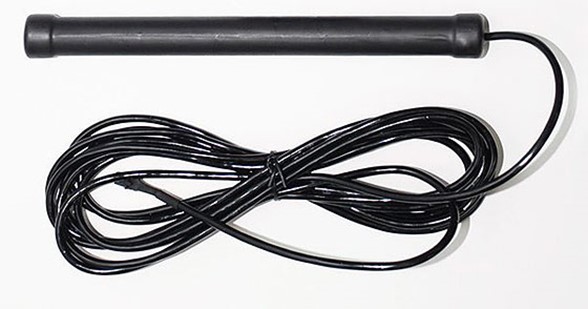If you are wondering what is the best driveway alarm (always subjective and dependent upon your requirements), let me offer my years of experience having installed and used all sorts of different wireless devices for my own home security – devices (e.g motion sensors / alarms) that are designed to alert you inside your home that a vehicle is approaching and/or coming down your driveway or private road…
I have finally installed what I believe is the best driveway alarm (that I currently am aware of), at least one that will not require lots of money or a professional installer – and it actually works for its intended purpose – to alert you that a vehicle is approaching.
The key word is ‘vehicle’, because this driveway alarm does not (thankfully) issue false alarms for animals, blowing tree branches, or any old thing that ‘moves’ in front of it, etc… I just want to be alerted for vehicles for this particular purpose.
The product that I’m talking about is:
Mighty Mule Wireless Driveway Alarm (FM231)
The ‘Mighty Mule’ company (no affiliation with this blog) designs devices for automatic gate openers. They also design a driveway alarm using their same sensor technology.
No False Alarms
The reason that their driveway alarm does not issue false alarms for non-vehicles (e.g. animals that happen to pass by or the wind blowing tree branches or bushes, etc…) is because they do not use the type of sensor that throws ‘a beam’ that simply gets interrupted or one that senses a thermal heat signature (infrared) when something passes in front of it.
Sensor Detects Surrounding Magnetic Field
Instead, the Mighty Mule utilizes a sensor ‘wand’ that is specially designed to ‘sense’ its surrounding magnetic field and any disturbances to that magnetic field. The sensor wand is designed to be buried out of sight – several inches deep, up to 12 inches deep – alongside the roadway or driveway, and is connected (via a weatherproof cable) to a transmitter device (also weather proof).
Driveway Alarm Transmitter
The transmitter utilizes two ‘AA’ batteries (use Lithium batteries for best performance) to send its signal to the receiver which is located inside the home.
How It Works
When a vehicle passes by within 15 feet of the electromagnetic sensor, the disturbance in the magnetic field (via the metal of the vehicle) triggers the transmitter to send an alert / alarm back to the receiver.
Driveway Alarm Indoor Receiver
An alarm sounds from the indoor receiver which has an adjustable volume control – letting you know that a vehicle has passed by the sensor.
There is also a low-battery indicator on the indoor receiver which lets you know when the transmitter batteries need to be replaced (a nice feature).
The receiver also has an LED that lets you know that the device has been triggered (in case you missed the audible alarm due to being somewhere else), and it will remain lit until you press a ‘reset’ button. This is another nice feature letting you know that a vehicle has passed by the sensor when you were away.
Great Security For Private Driveway Or Private Road
I happen to live at the end of a private road. It’s nice to know when a vehicle is coming down the road. Having this driveway alarm is especially comforting for ‘the middle of the night’ when there certainly should be no vehicle approaching. If the alarm is ever triggered in the wee hours of the morning, it will ‘buy time’ to get prepared for whatever may be heading this way…
Driveway Alarm Distance
The ‘Mighty Mule’ specification indicates that the driveway alarm will transmit up to 400 feet (ideal conditions). My own installation is at a distance of 330 feet including a number of trees in the way, and it works solid from there. I tried further, but the road dips down and becomes out of ‘the line of sight’ with the receiver (and there are lots more trees in the way) at the 400 foot mark. When I tested the distances (do this before digging the trench!) the 400 foot distance was marginal so I brought it in closer to be assured of a consistent signal.
Mighty Mule Installation Tips
When you insert the ‘AA’ batteries into the transmitter, it ‘takes a snapshot’ of the surrounding magnetic field via the sensor wand’s current position. It uses this reference ‘snapshot’ to detect subsequent differences in the magnetic field which will trigger the alarm. So, when inserting the batteries for testing (and when inserting the batteries for the last time after you’ve completed the installation) be sure that the environment within a 15 foot radius does not include ‘non-typical’ metal objects. For example, a shovel setting nearby, etc…).
Orient the sensor wand parallel with (in line with) the driveway.
Try to get best ‘line of sight’ between the transmitter location and the receiver. The more trees, buildings, walls, the less effective distance. For example, my receiver is setting on the bedroom window sill which faces the general direction of the transmitter.
Once I had determined the location for the transmitter and after I dug the trench for the wand, cable, and support post, I set the plastic support post (of the transmitter) in a shallow dug hole filled with a puddle of concrete for longevity and support, then threw some dirt on top for the grass to grow.
Paint the support post and the transmitter cover to match your surroundings. I used a ‘forest green’ spray paint.
CONCLUSION
An important aspect of overall preparedness is security. Depending on where you live and the layout of your property, this driveway alarm might be something that helps with yours.
Start now to make sure you are staying prepared.
Via: modernsurvivalblog






 Follow
Follow
Leave a Reply